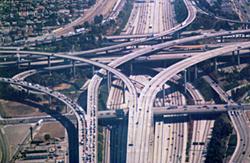| Revision as of 19:46, 7 September 2002 view source206.15.46.129 (talk) LACMA, Subheading change, Silverlake← Previous edit | Revision as of 20:53, 7 September 2002 view source 210.49.196.232 (talk)No edit summaryNext edit → | ||
| Line 38: | Line 38: | ||
| <b>Communities and Neighborhoods within the city of Los Angeles:</b> | <b>Communities and Neighborhoods within the city of Los Angeles:</b> | ||
| * ] | |||
| * ] | * ] | ||
| * ] | * ] | ||
Revision as of 20:53, 7 September 2002
Los Angeles (formerly El Pueblo de Nuestra Señora Reina de Los Angeles de la Porciuncula, "Town of Our Lady Queen of the Angels of the Small Portion") is a large coastal metropolis in southern California in the United States.
Los Angeles is the largest city in California, and the second largest in the United States, in terms of population, with a population of 3,694,820 as of the 2000 census. The Los Angeles metropolitan area (Los Angeles, San Bernardino, Riverside, Ventura and Orange Counties) is home to over 16 million people of diverse ethnic and economic background.
Los Angeles is the home of the Los Angeles Dodgers Major League Baseball team, the Los Angeles Lakers and Los Angeles Clippers National Basketball Association teams, the Los Angeles Sparks WNBA team, the Los Angeles Kings National Hockey League team, and the Los Angeles Galaxy Major League Soccer team. In suburban Orange County can be found the Mighty Ducks of Anaheim National Hockey League team and the Anaheim Angels Major League Baseball team.
History
The area was visited by the Spanish explorer Gaspar de Portolá in 1769, and in 1781 the town was founded. Located on the Los Angeles River, the town was a cattle ranching center. In 1846 the U.S. Army conquered the area. The arrival of the Southern Pacific railroad 1876 and the discovery of oil in the early 1890s stimulated expansion, as did the development of the movie industry in the early 20th century.
Expansion was not only economic, but also territorial; during the 1900s Los Angeles annexed many nearby cities and communities, from the port of San Pedro on the Pacific coast to the vast San Fernando Valley over the mountains to the north.
During World War II, Los Angeles grew as a center for production of war supplies and munitions, and thousands of African Americans migrated to the area to fill factory jobs. After the war massive immigration into surrounding suburban areas made Los Angeles enormously prosperous. In 1965, the African-American community of Watts was the site of six days of rioting that left 34 people dead and caused over $200 million in property damage. Race riots erupted again in 1992 after the acquittal of four white LAPD police officers accused of viciously beating an African-American motorist, Rodney King, while arresting him.
By the end of the 20th century, some of the annexed areas began to feel themselves cut off from the political process of the megalopolis, leading to a particularly strong secession movement in the San Fernando Valley. A proposed split of the city will be put before voters in November 2002.
Places / Things of Interest in and near the city
- Hollywood
- University of California, Los Angeles (UCLA)
- University of Southern California (USC)
- JPL (in Pasadena, California)
- Los Angeles County Museum of Art (LACMA)
- Griffith Park
- The La Brea Tar Pits
- Santa Anita Racetrack
- Hollywood Park Rracetrack
- Knott's Berry Farm
- Disneyland
- Occidental College
- Loyola Marymount University
- Pepperdine University
Communities and Neighborhoods within the city of Los Angeles:
- Camarillo
- Canoga Park
- Chatsworth
- Encino
- Granada Hills
- Hancock Park
- Hollywood
- North Hills
- Northridge
- Pacific Palisades
- Porter Ranch
- Reseda
- San Pedro
- Sherman Oaks
- Silverlake
- Tujunga
- Van Nuys
- Venice
- Watts
- West Hills
- Wilmington
- Winnetka
- Woodland Hills
Other nearby cities:

